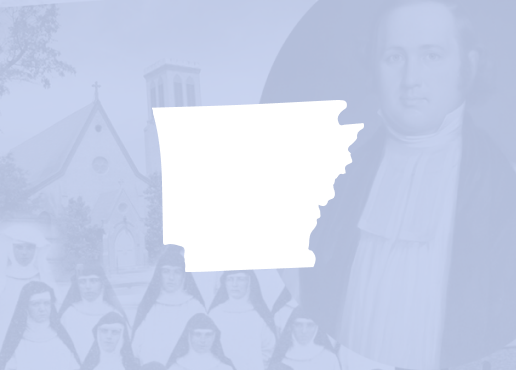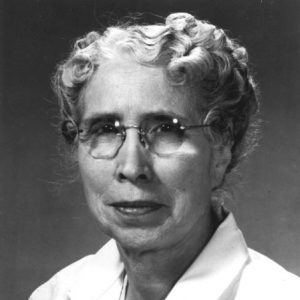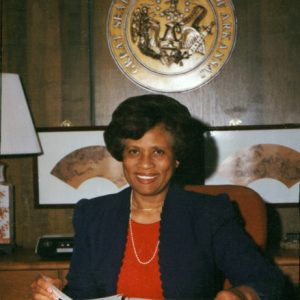calsfoundation@cals.org
Birth Control Movement
aka: Family Planning Movement
In Arkansas, early marriage and the need for farm labor had long encouraged large families. In addition, federal and state laws had restricted access to contraceptives since the late nineteenth century. These challenges did not, however, prevent women from using herbs, withdrawal-based, or “black market” birth control to exercise some measure of reproductive control.
In the 1940s, attempting to address poverty and inspired by the Planned Parenthood Federation of America’s (PPFA) policy agenda, Hilda K. Cornish of the Planned Parenthood Association of Arkansas and her allies campaigned for the inclusion of birth control services in Arkansas’s public health system. In 1940, Cornish, the Arkansas Medical Society (AMS), and state board of health members discussed plans for public health birth control services with the PPFA’s medical director. At the AMS annual meeting in 1941, however, physicians rejected a proposal to allow county health unit nurses to teach “contraceptive methods and devices to the indigent and physically unfit.” In 1944 and 1950, Cornish and her allies again tried and failed to secure the AMS’s approval for public health birth control services. AMS members based their rejection of these early birth control proposals not on moral or religious objections but on their opposition to state health department programs, grounded in fears of “socialized” medicine.
In the 1960s, the Little Rock American Association of University Women (LRAAUW) members and physicians at the University of Arkansas Medical Center—now the University of Arkansas for Medical Sciences (UAMS)—addressed the lack of access to, and information about, birth control in Arkansas, but they did so only in the language of population and poverty control rather than reproductive rights. Following the AMS endorsement of health department–based family planning programs in 1964, state health department officials began offering services in October of that year. The clinics provided birth control information and devices to married women, but unmarried women could obtain contraceptive advice only if they had already had children. By 1966, thirty health department family planning clinics served thirty-seven Arkansas counties.
In 1963 and 1964, two UAMS obstetrician/gynecologists, department head Dr. Willis E. Brown and resident Dr. E. Stewart Allen, conducted research on the use of the intrauterine contraceptive device (IUD). Allen, who had replaced the retiring UAMS obstetrics and gynecology professor and supporter of birth control Dr. Eva F. Dodge as a health department obstetrical consultant, directed the health department family planning programs. Physicians’ interest in the IUD indicated the Arkansas public health program’s emphasis on poverty control. Population control advocates targeted IUDs at poor women, whom they often viewed as too “irresponsible” and “unmotivated” to use contraceptives, because the devices were cheaper than birth control pills and did not require daily action. Allen and Brown noted that any woman who wanted a contraceptive method that was “inexpensive, highly effective, and require[d] no pre-coital action,” could use the IUD.
In 1964, the LRAAUW formed the “The American Family in a Changing World” committee to study the relationship between population and poverty and its impact upon the family and society. Chair Margaret R. Hower told Willis Brown that their committee was eager to support the new public health family planning program. Brown responded by outlining several ways in which clinic services might be expanded, including evening clinics for working mothers.
Federal antipoverty programs became a major source of financial assistance. In 1965, Dr. Calvin R. Ledbetter Jr., a political science professor at the University of Arkansas at Little Rock (UALR), became chair of the Pulaski County Health and Welfare Council-Division of Economic Opportunity (PCEO), the local representative of the Office of Economic Opportunity (OEO), the central “War on Poverty” entity. Hower explained to Ledbetter that the AAUW committee wanted the antipoverty program’s assistance for Pulaski County’s family planning clinics and identified evening clinics and patient financial assistance as goals of the proposed program expansion. Following Ledbetter’s affirmation that the PCEO would support family planning projects, Hower asked doctors Brown and Allen to submit plans and budgets to the PCEO. In October 1965, the PCEO approved a proposed family planning program plan and budget, formed with the assistance of Brown, Allen, and others. The grant proposal, which would require the national OEO office’s final approval, called for an executive director, two public health nurses, and a social worker, as well as evening clinics. Hower secured promises of support for the proposal from House Ways and Means Committee chair Wilbur D. Mills, Senator John L. McClellan, and others. Approved in 1966, the family planning program would include all the proposed staff members and evening clinics.
Opened in 1966, Pulaski County’s family planning clinic maintained a five-member staff and provided a once-weekly evening clinic at UAMS. By 1967, five Pulaski Economic Opportunity Agency (PEOA) clinics—three in Little Rock (Pulaski County), and one each in North Little Rock (Pulaski County) and Scott (Pulaski and Lonoke counties)—provided contraceptive advice and free birth control pills, IUDs, and diaphragms to married and unmarried women with children, requiring that patients under age twenty-one be married. The assistant director explained that poor women’s inability to afford the transportation costs to Little Rock led to the Scott clinic’s establishment. Dr. Joycelyn Elders, who began teaching at UAMS in 1966, also recalled that many poor women who sought family planning services encountered travel difficulties. Despite access problems, by 1967, the PEOA family planning programs had assisted more than 3,000 women. In 1969, the PEOA family planning program’s nurse administrator insisted that all patients were treated respectfully. In her book Poverty in the Land of Opportunity (1978), Henderson State University sociologist Juanita D. Sandford showed, however, that some public health family planning clinic staff treated patients disrespectfully.
By 1969, fifty-one Arkansas counties, in all regions of the state, reported subsidized family planning services provided through local health departments and hospitals. Despite the services’ existence, a 1971 Planned Parenthood survey indicated the inadequacy of the state’s family planning services for poor women, reporting that “Arkansas was one of 14 states in which 90 percent or more of the family planning needs remained unmet in 1969.” Arkansas’s OEO director drew upon the Planned Parenthood survey to explain an OEO planning grant intended to improve family planning services. In 1971, an OEO grant led to the formation of the Arkansas Family Planning Council (AFPC), which coordinated all the state’s family planning efforts.
Signed into law by Governor Dale Bumpers in 1973, the Arkansas Family Planning Act (AFPA) stated that all contraceptive information and supplies would be available to all people, regardless of age, race, sex, income, or motive, though a “refusal clause” allowed medical and pharmacy professionals with religious objections against contraception to refuse to supply contraceptive advice and supplies. In 1974, Dr. E. Stewart Allen of the AFPC reported that, by the end of November 1973, more than 20,000 indigent women had received services.
In the 1970s, however, changes began to take place that began to undermine support of family planning as a part of health policy. Feminists’ claims of birth control and abortion as rights provoked bitter opposition from New Right conservatives, who helped elect Republican Ronald Reagan president in 1980. Reagan’s cuts in federal funding for family planning meant that, though the AFPC remained in existence, many Arkansas family planning agencies would lose a portion of their funding.
In the late 1980s, attempting to address Arkansas’s high teenage pregnancy rate, state health director Dr. Joycelyn Elders proposed that school-based medical clinics be allowed to offer pregnancy counseling and distribute condoms, provoking intense opposition from social conservatives. Despite such opposition, by the early 1990s, school boards at Lincoln High School in Washington County and Little Rock Central High School had approved contraceptive advice (excluding abortion) as a part of school health clinic services.
Arkansas passed laws requiring that prescription drug–inclusive health insurance plans cover contraceptives (excluding abortion and emergency contraception) and that sexual assault victims receive information about emergency contraception. Both laws, however, allowed conscientious objectors to refuse to provide contraceptive information. Adults and teens, regardless of ability to pay, can obtain family planning service at the Arkansas Department of Health’s county health units. Arkansas’s Medicaid Family Planning Waiver enables women of childbearing age with incomes at or below 200% of the federal poverty level to receive coverage for family planning services.
In March 2021, Arkansas passed a law allowing pharmacists to prescribe six-month supplies of oral contraceptives to people eighteen years old and above; visits to primary-care physicians are required before another six-month supply can be prescribed.
For additional information:
Arbana, Michael. “Lawsuit Seeks Halt to Dispensing Condoms at School Clinics.” Arkansas Democrat-Gazette, September 27, 1991, p. 1B.
Benda, Brent B., and Robert Flynn Corwyn. “Abstinence and Birth Control among Rural Adolescents in Impoverished Families: A Test of Theoretical Discriminators.” Child and Adolescent Social Work Journal 16 (June 1999): 191–214.
Elders, Joycelyn, and David Chanoff. From Sharecropper’s Daughter to Surgeon General of the United States of America. New York: William Morrow and Company, Inc., 1996.
“Family Planning.” Arkansas Department of Health. https://www.healthy.arkansas.gov/programs-services/topics/family-planning (accessed July 5, 2022).
Leung, Marianne. “‘Better Babies’: The Arkansas Birth Control Movement during the 1930s.” PhD diss., University of Memphis, 1996.
———. “‘Better Babies’: Birth Control in Arkansas during the 1930s.” In Hidden Histories of Women in the New South, edited by Virginia Bernhard, Betty Brandon, Elizabeth Fox-Genovese, Theda Perdue, and Elizabeth Hayes Turner. Columbia: University of Missouri Press, 1994.
———. “Making the Radical Respectable: Little Rock Clubwomen and the Cause of Birth Control during the 1930s.” Arkansas Historical Quarterly 57 (Spring 1998): 17–32.
Marshall, S. Alexander, Nichola Driver, and M. Kathryn Allison. “Attitudes towards Contraception: Focus Groups with Arkansas Teenagers and Parents.” Sex Education 21.2 (2021): 161–175.
Peacock, Leslie Newell. “The Last to Know.” Arkansas Times, July 11, 2003, pp. 10–12.
Welch Melanie K. “Not Women’s Rights: Birth Control as Poverty Control in Arkansas.” Arkansas Historical Quarterly 69 (Autumn 2010): 220–244.
———. “Politics and Poverty: Women’s Reproductive Rights in Arkansas, 1942–1980.” PhD diss., Auburn University, 2009.
Wickline, Michael R. “No-Prescription Birth-Control Bill Goes to Governor.” Arkansas Democrat-Gazette, March 18, 2021, p. 4A.
Melanie K. Welch
Mayflower, Arkansas

 Eva Dodge
Eva Dodge  Joycelyn Elders
Joycelyn Elders  Rally for Reproductive Justice
Rally for Reproductive Justice 



Comments
No comments on this entry yet.